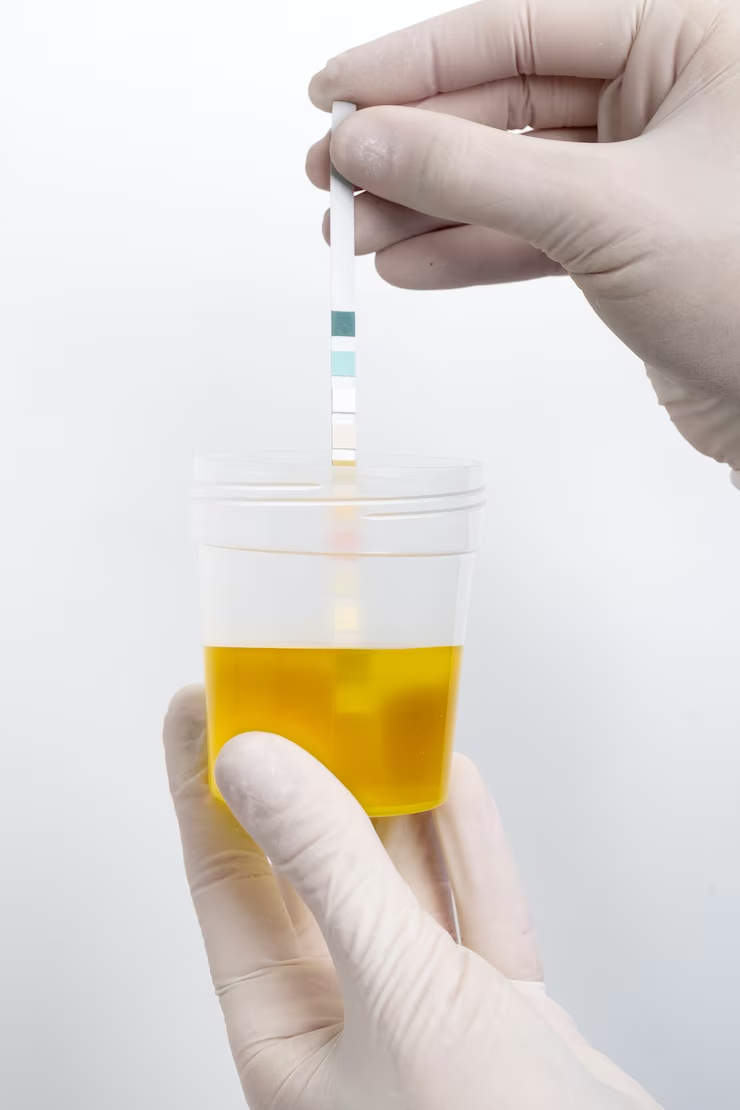- What other reasons make testing necessary
- When to take a general urine test during pregnancy
- Types of Urine Tests During Pregnancy
- Rehberg Test
- Nechiporenko Test
- Urine Culture
- Zimnitsky Urine Test
- Preparation for Clinical Urine Analysis During Pregnancy
- Important Indicators and Reference Values
- What other indicators does the interpretation contain
- Possible Deviations from the Norm and Their Causes
- Poor Urine Test: What Can Be Revealed
- Why is it necessary to monitor non-standard indicators?
Urine testing during pregnancy, like many other mandatory examinations, ensures the health of the expectant mother, successful gestation, and the safe birth of the child. It is no exaggeration to state that monitoring the woman’s condition during pregnancy is crucial for the proper development of the fetus, avoiding complications during childbirth, and preventing any abnormalities after the baby is born.
When planning pregnancy management, the gynecologist overseeing it creates a schedule for collecting tests by trimesters, reflecting the changes occurring in the female body and corresponding to the stages of fetal development. It is important for the expectant mother to strictly adhere to the research schedule, including correctly and timely submitting urine tests.

Tests: Why They Need to Be Done
An objective picture of a woman’s health during pregnancy can only be reflected in the test results that the pregnant woman will submit in a timely manner. This concerns the functioning of all organs and systems of the body, not only of the future mother but also of the developing fetus. The double load that the woman’s body experiences during this period is not always within its capacity, as evidenced by the indicators of key parameters monitored through urine analysis during pregnancy.
The kidneys, which perform the function of excreting metabolic products not only for the pregnant woman but also for the child, work twice as hard during gestation. Additionally, the active growth of the uterus leads to compression of the abdominal organs, including the ureters. This situation can cause urine stagnation, kidney edema, and infections that ascend to the kidneys from the bladder.
What other reasons make testing necessary
The weakening of the immune system and hormonal changes that lead to the relaxation of the ureters are important reasons that make urine tests during pregnancy necessary. This provokes infectious processes and exacerbates chronic ailments of the urinary system.
In addition, a urine test during pregnancy is prescribed for the timely diagnosis of pathological processes occurring in the urinary and other internal systems and organs; monitoring the course of identified diseases, and developing and consistently evaluating the course of ongoing therapy.
The study will help not to miss the alarming signs of late toxicosis (gestosis), which poses a danger to the life of the expectant mother and her baby. A general urine test during pregnancy, combined with certain symptoms, helps to determine the degree of gestosis and prevent the development of pathology.
When to take a general urine test during pregnancy
A woman expecting a child undergoes various tests almost every time she visits her obstetrician. However, the most frequently prescribed laboratory test during pregnancy is the general urine test. This happens not only at the early stages of pregnancy but with increasing frequency up to the moment the baby is born.
The schedule for this analysis for a pregnant woman is as follows:
- first trimester – once every 4 weeks;
- second and the beginning of the third trimester – once every 2 weeks;
- from the 35th week onwards – weekly.
In general, a woman typically has a general urine test during every visit to the obstetrician, starting from the first visit to the clinic for confirming pregnancy and registration until the time of delivery.

Types of Urine Tests During Pregnancy
In addition to the general urine test during pregnancy, there are other types of testing. These are prescribed if bacteria are found in the general test to determine their quantity, type, and sensitivity to antibacterial agents, as well as if there is a need to identify leukocytes, erythrocytes in the urine, or in cases of suspected preeclampsia and other situations. Like the general test, these analyses require thorough preparation to ensure that the results are as accurate as possible.
Such special urine tests during pregnancy include investigations:
- Rehberg test
- by Nechyporenko;
- urine culture;
- by Zimnitsky.
Each of these types of tests has guidelines on how to correctly collect urine for analysis, as well as standards for the measured parameters.
Rehberg Test
This method of urine analysis is designed to determine the kidneys’ ability to filter urine and is prescribed for diabetes, urinary tract infections, preeclampsia, and kidney diseases. Urine is collected in one container over the course of a day, which should be stored in the refrigerator during the collection period. Once the process is complete, the contents of the container are measured, thoroughly mixed, and 70-100 ml is poured into a jar or a special container.
Then the urine is delivered to the laboratory. When submitting, it will be necessary to report the total volume of urine collected over the day. To ensure the test is submitted correctly, you need to refrain from consuming coffee and strong tea, and avoid intensive physical activity. After obtaining and comparing the results with the norms, if there is a deviation from the norm, it is concluded that there is a decrease in kidney filtration levels, which confirms kidney damage in severe pregnancy complications.

Nechiporenko Test
This urine test during pregnancy is prescribed to determine the number of leukocytes, erythrocytes, and casts in 1 ml of substance in order to detect an inflammatory process in the urinary system of a pregnant woman if the general analysis showed changes. The examination provides more reliable results than a regular general analysis and also allows monitoring of the prescribed and ongoing therapy in dynamics.
During pregnancy, the normal Nechiporenko urine analysis in 1 ml is: leukocytes – less than 2 thousand, erythrocytes – less than 1 thousand, casts – less than 20. Increased normative indicators usually indicate the presence of pyelonephritis, glomerulonephritis, cardiovascular diseases, or arterial hypertension in the expectant mother respectively.
Urine Culture
If a general urine test reveals bacteria, a culture is done to determine the number of bacteria, their type, and sensitivity to specific medications.
Accurate results are ensured by collecting urine with the vagina closed with a cotton swab and only after thoroughly cleaning the external genital organs. In this case, the middle portion of urine is collected in a sterile container and delivered to the laboratory within one and a half to two hours.
It will take an average of 7-10 days to obtain the result and for the doctor to decide on the necessity of antibacterial treatment and the choice of drugs. Until the culture results are obtained, if there is clinical evidence of inflammation, antibacterial therapy with a broad-spectrum antibiotic is administered. If the disease is asymptomatic or the symptoms are mild, treatment is not provided until the urine test results are obtained.
Zimnitsky Urine Test
This urine test is conducted to detect hidden edema and clarify the kidneys’ ability to concentrate and dilute urine. It is usually required if there is a suspicion of diabetes, the development of gestosis, kidney failure, or infections of the urinary system. To correctly collect urine for the test, the collection is carried out over 24 hours in 8 containers, taking into account the volume of liquid consumed, including fruits, vegetables, and soups. Urine at 6 a.m. is not collected; afterward, all subsequent urine is poured into signed containers with a clear schedule and a three-hour period – from 6 to 9 a.m., from 9 to 12, and so on, with the last collection from 3 to 6 a.m. Normal values include:
- priority of daytime urination;
- daily urine volume – within 1.5 liters;
- urine output of 70-80% of the liquid consumed per day.
Deviations from the established characteristics indicate kidney dysfunction.
Preparation for Clinical Urine Analysis During Pregnancy
The process of preparing for an analysis during pregnancy includes regular restrictions and a series of hygienic procedures. Thus:
- for 2 days prior to urine collection, diuretics are excluded;
- the day before collecting the biomaterial, abstain from consuming alcohol, fruits, vegetables, red wine, multivitamins affecting urine color, and physical activities;
- half a day before the urine test during pregnancy, refrain from sexual intercourse;
- immediately before collecting urine, perform genital hygiene; to prevent vaginal secretions from entering the biomaterial, place a cotton swab in the vagina;
- at the first morning urination, collect a midstream urine sample (collection is possible throughout the day at any time).
Furthermore, it is advisable to avoid touching the container with your body when collecting the biomaterial. Delivery to the medical facility is preferable within 2 hours after collection.
Important Indicators and Reference Values
Urinalysis during pregnancy is carried out to assess various parameters. Without equipment, organoleptic properties are evaluated. The color should be straw or bright yellow, the smell should be mild and specific, transparency should be absolute, and there should be little foam when shaken.
As for other characteristics, their standard indicators are reflected in the table, which presents the standards for deciphering some indicators of the general urinalysis:
| Indicator Name | Normal Value |
| Acidity | 5-7 |
| Color | Straw |
| Density | 1,010 – 1,025 |
| Protein | None or 0.033 g/l |
| Bilirubin | None or up to 8.5 μmol/l |
| Glucose | None or up to 1 mmol/l |
| Erythrocytes | up to 2 per field of view |
| Ketone bodies | none or up to 0.5 mmol/l |
| Urobilinogen | none or up to 35 µmol/l |
| Salts | none |
| Leukocytes | up to 5 per field of view |
However, it is best to discuss the interpretation of the analysis results with a doctor.
What other indicators does the interpretation contain
In addition to the main indicators, among those shown in the urine test during pregnancy,
they may find flat epithelium – superficial cells of the skin of the external genital organs, detection of which in the biomaterial is not of diagnostic significance. Transitional epithelium may also be found – located in the upper part of the urethra, bladder, ureters, kidneys. Single cells may be found in the urine sediment of healthy people.
A large number of them indicate intoxications, jaundice, chronic cystitis, kidney stones, and may occur after surgical interventions on the urinary tract. Detected kidney epithelium may be a consequence of nephritis and nephrosis. Bacteria in the biomaterial indicate a urinary tract infection, unless contamination occurred from vaginal discharges or skin flora.
Possible Deviations from the Norm and Their Causes
Urine analysis during pregnancy is not always “good,” meaning that sometimes the main indicators do not meet established medical standards. Such deviations generally indicate developing or pre-existing serious illnesses that can not only adversely affect the health of the expectant mother and her child but also pose a direct threat to their lives.
Such deviations have their causes. However, in some cases, the identification of deviations from normative indicators is not a result of a progressing disease, but occurs solely because the rules on how to collect a urine test during pregnancy were not followed.
Poor Urine Test: What Can Be Revealed
If studies conducted in early stages or in the last trimester reveal, for example, ketone bodies, their detection may be due to decompensation of diabetes and the risk of developing hyperglycemic coma. The presence of acetone in urine is a consequence of serious diseases of the digestive tract, blood, or liver. Glucose in urine may appear due to carbohydrate metabolism disorders, indicating the development of gestational diabetes.
Combined with high blood pressure and swelling of the shins, face, and hands, an elevated protein level indicates that the pregnant woman is developing preeclampsia, where the developing fetus is deprived of the necessary nutrients and oxygen. The presence of mucus in the biomaterial may indicate a chronic inflammatory process in the urinary tract.
Why is it necessary to monitor non-standard indicators?
If the tests taken by a pregnant woman deviate significantly from the normal parameters, the doctor examines each item individually as well as the overall situation in order to accurately assess the condition of the pregnant woman and her fetus. A treatment plan is then developed, medications are prescribed, and the patient’s condition is monitored over time.
Even in healthy women, the composition of urine changes significantly depending on drinking habits, diet, and medication intake. Consistent monitoring of these components in accordance with the existing biomaterial collection schedule allows for keeping key parameters in check that characterize the health of the expectant mother and her child. This is necessary to promptly raise alarms and take urgent appropriate actions.



Download the app and get 7 days free use
 eng
eng rus
rus deu
deu spa
spa fra
fra ita
ita por
por srp
srp tur
tur ukr
ukr por
por bos
bos



